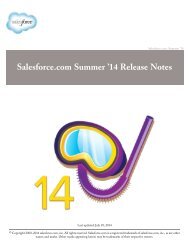salesforce_security_impl_guide
salesforce_security_impl_guide
salesforce_security_impl_guide
Create successful ePaper yourself
Turn your PDF publications into a flip-book with our unique Google optimized e-Paper software.
Securing and Sharing Data<br />
Editing Permission Sets from a List View<br />
Editing Permission Sets from a List View<br />
You can change permissions in up to 200 permission sets directly from the list view, without<br />
accessing individual permission sets.<br />
Note: Use care when editing permission sets with this method. Making mass changes may<br />
have a widespread effect on users in your organization.<br />
1. Select or create a list view that includes the permission sets and permissions you want to edit.<br />
2. To edit multiple permission sets, select the checkbox next to each one you want to edit. If you<br />
select permission sets on multiple pages, the selections on each page are remembered.<br />
3. Double-click the permission you want to edit. For multiple permission sets, double-click the<br />
permission in any of the selected permission sets.<br />
4. In the dialog box that appears, enable or disable the permission. In some cases, changing a<br />
permission may also change other permissions. For example, if “Manage Cases” and “Transfer<br />
Cases” are enabled in a permission set and you disable “Transfer Cases,” then “Manage Cases”<br />
is also disabled. In this case, the dialog box lists the affected permissions.<br />
5. To change multiple permission sets, select All n selected records (where n is the number<br />
of permission sets you selected).<br />
6. Click Save.<br />
EDITIONS<br />
Available in:<br />
• Enterprise<br />
• Performance<br />
• Unlimited<br />
• Developer<br />
• Database.com<br />
USER PERMISSIONS<br />
To edit multiple permission<br />
sets from the list view:<br />
• “Manage Profiles and<br />
Permission Sets”<br />
If you edit multiple permission sets, only those that support the permission you are changing will change. For example, if you use inline<br />
editing to enable “Modify All Data” in a permission set, but because of its user license the permission set doesn't have “Modify All Data,”<br />
the permission set won't change.<br />
If any errors occur, the error message lists each permission set and a description of the error. Click the permission set name to open its<br />
overview page. The permission sets you've clicked appear in the error window in gray, strike-through text.<br />
Any changes you make are recorded in the setup audit trail.<br />
Working in a Permission Set's Overview Page<br />
A permission set's overview page provides an entry point for all of the permissions in a permission<br />
set. To open a permission set overview page, from Setup, click Manage Users > Permission Sets<br />
and select the permission set you want to view.<br />
From the permission set overview page, you can:<br />
• Search for permissions and settings<br />
• Create a permission set based on the current permission set<br />
• If it's not assigned to any users, remove the permission set by clicking Delete<br />
• Change the permission set label, API name, or description by clicking Edit Properties<br />
• View and manage the users assigned to the permission set<br />
• Under Apps and System, click any of the links to view or edit permissions and settings.<br />
EDITIONS<br />
Available in: Enterprise,<br />
Performance, Unlimited,<br />
Developer, and<br />
Database.com Editions<br />
Visualforce is not available<br />
in Database.com<br />
USER PERMISSIONS<br />
To delete permission sets<br />
and edit permission set<br />
properties:<br />
• “Manage Profiles and<br />
Permission Sets”<br />
27






